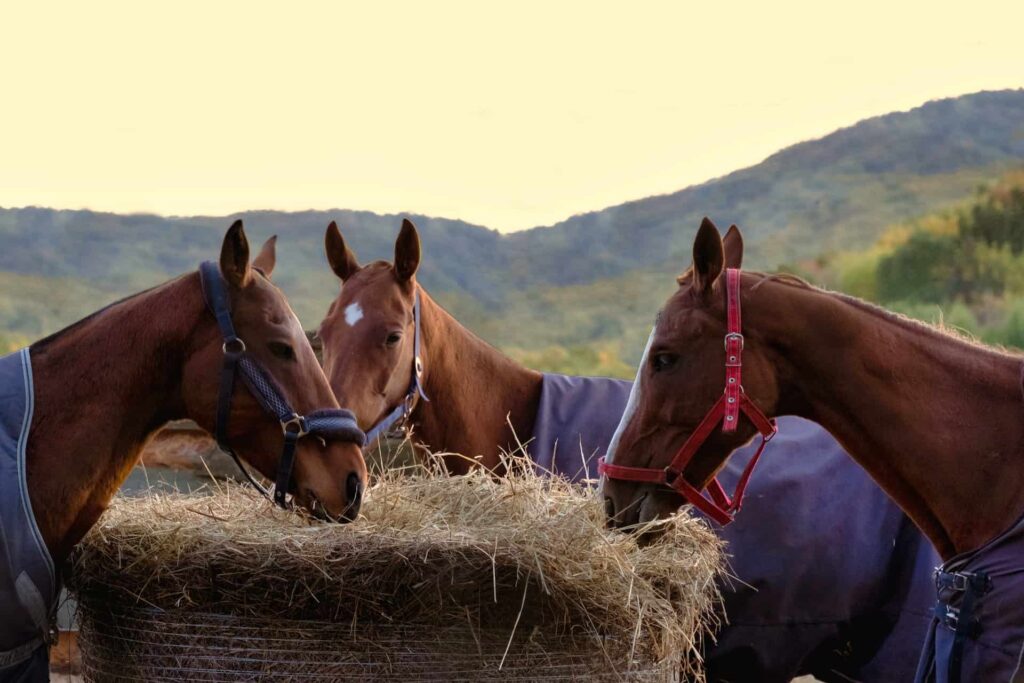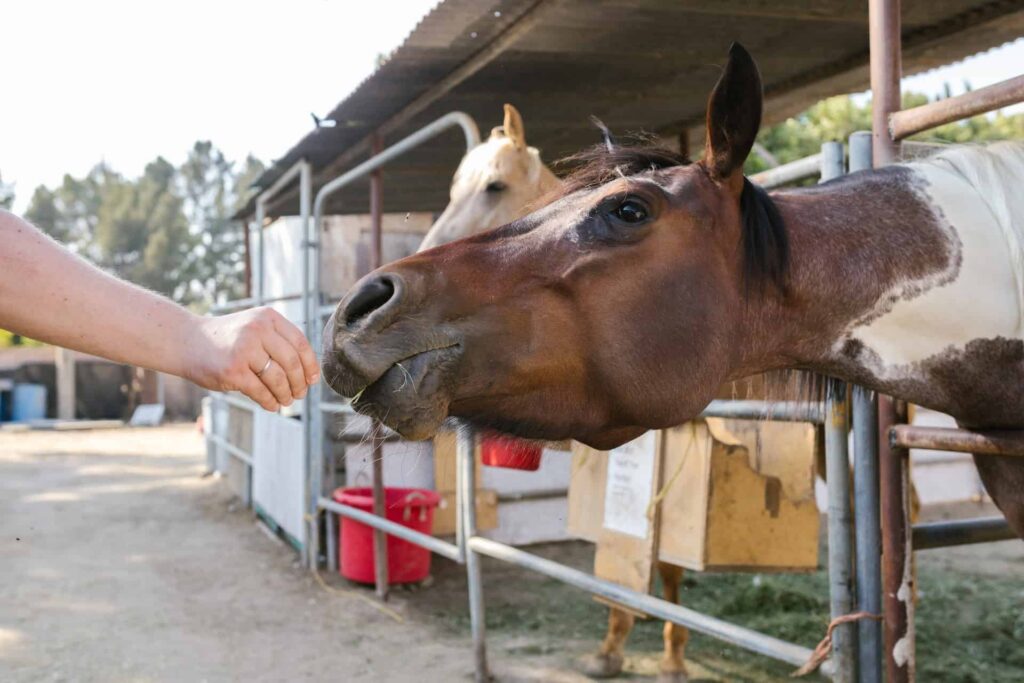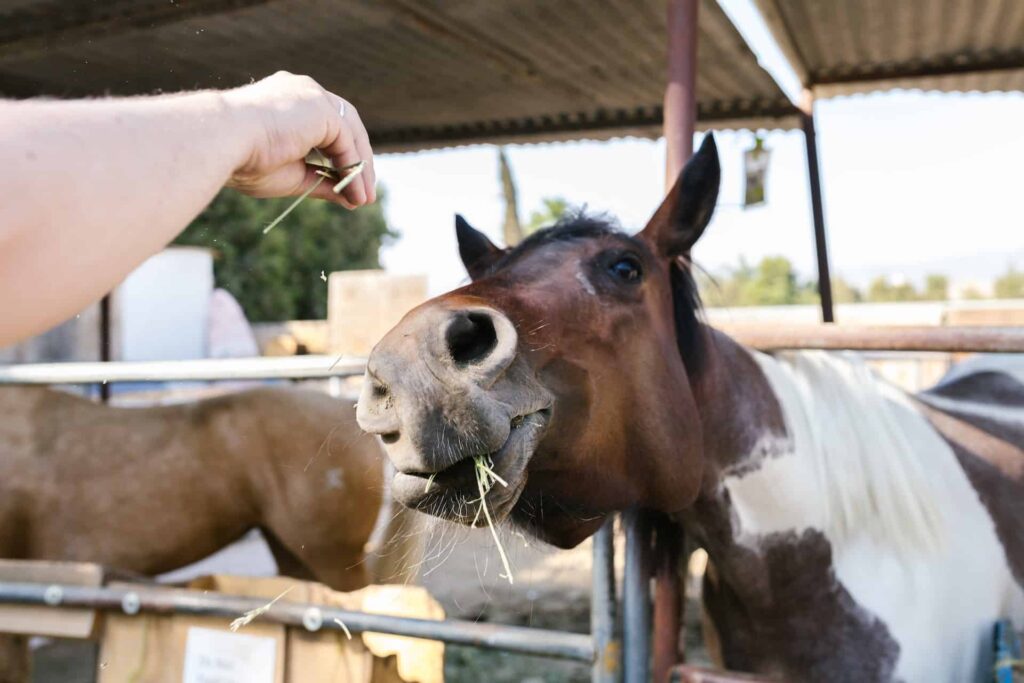Horse feeding is an important aspect of horse care and plays a significant role in the overall health and performance of these majestic creatures. A well-balanced diet is crucial for equine health, considering factors such as age, weight, activity level, and individual nutritional needs. Understanding the types of feed available and the various feeding systems can greatly improve the quality of life for horses, making it imperative for horse owners and caretakers to be aware of the fundamentals of equine nutrition.
One aspect to keep in mind is the importance of feeding horses based on their age, weight, and workload. Different life stages, such as foals, pregnant mares, or older horses, require different nutritional approaches. Additionally, health concerns can arise when horses are not fed appropriately, making it important to establish and follow specific guidelines to properly support their growth, maintenance, and performance. Ultimately, familiarizing oneself with the frequently asked questions of horse feeding can lay the groundwork for successful equine management.
Key Takeaways
- A balanced diet is crucial for maintaining equine health and performance.
- Tailoring feeding practices to a horse’s age, weight, and workload can prevent health issues.
- Familiarity with equine nutrition guidelines leads to better horse care and management.
Understanding Horse Nutrition
Proper horse nutrition is crucial for maintaining a healthy and active horse. It consists of a balanced diet containing all the necessary elements such as body weight, water, energy, minerals, vitamins, protein, amino acids, carbohydrates, fats, proteins, trace minerals, and digestible energy.
Body weight plays a role in determining the nutritional requirements of a horse. A horse’s diet should be tailored to its specific weight and activity level, with consideration given to factors such as age, workload, and any special needs or issues the horse may have.
Water is one of the most crucial components of horse nutrition, as it helps regulate body temperature, aids digestion, and supports overall bodily functions. A horse should always have access to fresh, clean water, and consumption may vary depending on factors such as environment and activity level.
Energy is primarily derived from three sources: carbohydrates, fats, and proteins. Horses require a certain amount of energy per day, which can be calculated based on their body weight, workload, and physiological state (e.g., pregnancy or lactation). The majority of a horse’s energy comes from carbohydrates, specifically fiber, which can be found in various forms of forage like hay and pasture grasses.
Minerals and trace minerals are aid in various bodily functions, including bone growth and maintenance, enzyme activity, and muscle contractions. Some key minerals required for good horse nutrition include calcium, phosphorus, magnesium, sodium, and potassium. Trace minerals such as copper, zinc, and selenium are also crucial, though required in smaller amounts.
Vitamins are vital for supporting metabolic processes, growth, and overall health. Horses require vitamins A, D, E, and K, as well as B-complex vitamins. Some of these can be obtained through natural forage sources and others through supplementation, depending on the horse’s dietary needs and availability of resources.
Protein is an important component of horse nutrition, needed for growth, tissue repair, and maintenance. It contains amino acids which a horse’s body cannot produce on its own. Quality protein sources include alfalfa, soybean meal, and linseed meal. The amount of protein needed will vary depending on factors such as age, workload, and reproductive state.
Related: Do Horses Eat Meat?
Fats are crucial for providing a concentrated source of energy, fatty acids, and as carriers for fat-soluble vitamins. They also contribute to the overall health of the horse’s skin, hooves, and coat. Fatty acid requirements can be met through forage, compound feeds, and supplementation, as needed.
Understanding horse nutrition involves carefully considering each of these components and tailoring a horse’s diet to its specific needs, ensuring that it receives all the essential nutrients for optimal health and performance. A horse owner must remain knowledgeable and proactive in monitoring their horse’s nutrition and making any necessary adjustments. It’s always a good idea to consult with a veterinarian or equine nutritionist to ensure the horse is receiving the appropriate nutrients in the correct amounts.
Types of Feed

Grasses and Hay
Horse diets are primarily based on forage, which can include grasses and hay. Horses typically graze on grass for multiple hours each day. Some common grasses used as horse feed include orchard grass and other grasshays. Hay provides horses with essential nutrients like fiber, helping them maintain a healthy digestive system. The quality of hay is critical, as good hay should be green in color, free from mold, and have a pleasant smell.
Grain and Concentrates
Horses may consume grains and concentrates such as oats, corn, and barley as a supplement to their grass and hay-based diet. Cereal grains provide horses with energy, but their overconsumption can lead to health issues if not balanced properly. It is important to closely monitor and control the amount of grain and concentrates provided to horses to maintain their overall well-being.
Supplements
To ensure that a horse receives a balanced diet, it may be necessary to include supplementary nutrients such as copper, phosphorus, calcium, magnesium, and electrolytes. These supplements are often incorporated into a horse’s feed when their diet requires additional nutrients not found in the grasses, hays, and grains they consume.
Unfit for Feeding
The quality of horse feed is crucial for maintaining good health. Poor-quality feed can include mold, which is harmful to horses. It is vital to consider the storage and handling of feed to prevent contamination and spoilage. Regularly inspect horse feed for any signs of mold, off-odors, discoloration, or insect infestations.
Special Feeds
Certain horse feeds, such as alfalfa and other legumes, may be fed as part of a horse’s diet to provide specific nutritional needs. Introducing these special feeds in a concentrate ration should be done carefully and under the guidance of a veterinarian or equine nutritionist to ensure that the horse maintains optimum health.
Related: What Do Horses Eat?
Feeding Systems and Schedules
Pasture Feeding
Horses are natural grazing animals and thrive in pastures where they can graze on fresh grass. A good pasture provides horses with essential nutrients, making it an ideal feeding system for horses with light workloads. Supplemental hay may be necessary in situations where the pasture quality is not sufficient or during specific seasons when grass growth is limited. Maintaining pastures in optimal conditions is crucial for horses’ overall health, ensuring that they receive a well-rounded and balanced diet.
Moderate and Hard Work Feeding
For horses in moderate to hard work, such as those in training or performing heavy duties, a higher energy intake is necessary to meet their nutritional demands. In addition to pasture grazing and supplemental hay, these horses may also require a well-balanced diet that includes grains, commercial concentrates, and additional vitamins and minerals. Carefully monitor the horse’s weight, body condition, and performance during training to adjust its diet accordingly and prevent health issues or decline in performance.
Multiple Feedings
Feeding horses multiple times a day has several benefits, including improved digestion and reduced stress due to prolonged periods of hunger. Horses have a small stomach capacity, so providing them with small amounts of feed at various times throughout the day mimics their natural eating habits. Ideally, horse owners should aim to spread out the feedings over 2-3 times per day, ensuring that the horse has access to forage for most of the day. This feeding schedule can also decrease the risk of gastric ulcers and other digestive diseases, contributing to the overall well-being of the horse.
Feeding Based on Age and Weight
Growth and Development Feeding
During the growth and development stage, it is crucial to provide the horse with a balanced diet to support healthy bone and muscle growth. Young horses between the ages of 6 to 12 months require higher feed intakes for their growth and development needs. Monitor the growth rate of the horse and adjust the feeding amounts accordingly, as underfeeding or overfeeding can lead to developmental issues.
To monitor a young horse’s growth, owners can use body condition scoring as a tool to assess if the animal is receiving adequate nutrition. The body condition score ranges from 1 (emaciated) to 9 (obese), with an ideal score for growing horses being around 5.
Here are some general guidelines for feeding growing horses:
- Provide high-quality forage like hay or grass to make up the bulk of the diet.
- Offer a balanced concentrate feed formulated specifically for the young horse’s age and size.
- Ensure a proper intake of vitamins and minerals to support growth and development, such as calcium and phosphorus for bone formation.
Weight Management
Maintaining a healthy weight is critical for the horse’s overall health and well-being. Aside from age, factors such as body condition score, breed, metabolism, and level of activity should be taken into consideration when determining the appropriate feed quantity and type.
For weight management, assessing the horse’s body condition score regularly is vital. Here are some key aspects to consider:
Weight Gain:
If the horse’s body condition score is below 5, a weight gain is necessary. Adjusting the diet should entail:
- Increasing the amount of high-quality forage and concentrate feed.
- Incorporating higher-calorie feeds such as grains or fat-rich supplements.
- Monitoring the horse’s progress and adjusting the feeding plan as needed.
Weight Loss:
If the horse’s body condition score is above 5, a weight loss plan may be required, which includes:
- Reducing the amount of concentrate feed or choosing one specifically for weight loss.
- Increasing the intake of low-calorie forage like grass or hay.
- Including more exercise or physical activities in their routine.
It is crucial to implement weight management strategies gradually and consistently, ensuring that the horse remains healthy and receives adequate nutrition.
Health Concerns in Horse Feeding
Colic and Digestive Disturbances
One of the primary health concerns in horse feeding is colic, a condition characterized by abdominal pain and digestive disturbances. Colic can be caused by factors such as an improper diet, inadequate water intake, and sudden changes in feeding habits. The digestive system of a healthy horse relies on a balance of microbes, including bacteria and protozoa, in the small intestine and hindgut to break down and absorb nutrients from feed.
When the balance of these microbes is disrupted, digestive disturbances can occur, leading to gas accumulation, impactions, and even displacement of the intestines. To maintain optimal horse health, provide a consistent and balanced diet, monitor water intake, and make gradual changes to feeding practices when necessary.
Stall Vices
Another health concern related to horse feeding is the development of stall vices. These are undesirable behaviors that horses may exhibit as a result of stress, boredom, or an improper diet. Some common stall vices include:
- Cribbing: When a horse grips a solid object with its teeth and swallows air, which can lead to digestive disturbances.
- Wood chewing: The horse chews on wooden surfaces, potentially causing damage to the teeth and stable infrastructure.
- Weaving: The horse repetitively shifts its weight from one front foot to the other, which may lead to joint problems.
- Pawing: The horse repeatedly digs its hoof into the ground, creating uneven surfaces and damaging the hoof.
To prevent the development of stall vices, it is crucial to ensure proper feeding practices, high-quality feed, and sufficient environmental enrichment. This includes providing horses with appropriate forage, vitamins, and minerals to maintain a balanced diet and support overall health. Additionally, offering toys or rotating pastures can help alleviate boredom and reduce the likelihood of developing these undesired behaviors.
Feeding Guidelines

To provide adequate nutrition, it is important to understand the specific needs and requirements of each horse. Here are some basic feeding guidelines while considering factors such as age, activity level, and overall health.
The National Research Council recommends adjusting feed intake according to the horse’s body weight and workload. For example, a horse weighing 500 kg requires approximately 2.5% of its body weight to feed daily. This percentage can be adjusted as necessary to meet changes in activity level, growth, or pregnancy.
There are several types of feed that can be used to meet a horse’s nutritional needs. These include hay, grains, fortified feeds, and supplements. When selecting the type of feed, consider the horse’s age, digestive capacity, and any health conditions.
Regarding hay, provide an adequate supply of good quality forage as the foundation of a horse’s diet. Hay should ideally account for 1.5% to 2% of the horse’s body weight, with the remaining portion of the diet consisting of concentrates or supplements depending on activity level and specific requirements.
Grains and fortified feeds are common sources of energy in a horse’s diet. When selecting a concentrate feed, it is crucial to choose one that is designed to meet the horse’s specific needs. For instance, older or geriatric horses may require a feed formulated specifically for them. Grains and concentrates should typically make up no more than 0.5% to 1% of the horse’s body weight.
Supplements can be added to a horse’s diet to ensure they receive all necessary vitamins and minerals. However, it is important to know the nutritional content of the base diet before adding supplements. Over-supplementation can lead to health problems and wasted resources.
Providing adequate nutrition for horses requires a thorough understanding of their specific needs. By following established feeding guidelines and considering factors such as age, activity level, and health, horse owners can ensure their equine companions are receiving the nutrition they need to thrive.
Frequently Asked Questions
What is the ideal feeding schedule for a horse?
The ideal feeding schedule for a horse depends on their individual needs, workload, and available forage. Generally, horses should be fed small meals throughout the day, as their digestive system is designed for continuous grazing. Aim to provide hay or pasture for the horse to graze on throughout the day, with additional concentrated feeds if necessary.
How much hay should be given to a horse daily?
The amount of hay that should be given to a horse daily depends on the horse’s weight, age, and activity level. As a general guideline, horses should be provided with 1.5% to 2.5% of their body weight in forage per day, mostly in the form of hay or pasture. For a 1,000-pound horse, this translates to approximately 15 to 25 pounds of hay daily.
What types of feed are suitable for horses?
Horses require a diet that primarily consists of forage, such as hay, pasture, or haylage. Some horses may benefit from concentrated feeds like grains, pellets, or extruded feeds depending on their specific needs. Consider the horse’s age, workload, and health status when selecting the appropriate types of feed.
Are there any foods that are harmful to horses?
Yes, there are certain foods that can be harmful to horses. Some examples include avocados, chocolate, caffeine, onions, garlic, and fruit seeds or pits, such as apple seeds or cherry pits. Additionally, horses should not consume large quantities of high-sugar treats or human foods that are high in fat or salt.
Do horses require additional grain if they have access to grass?
Not all horses require additional grain if they have access to quality grass. However, horses with higher energy needs, such as those in intense work or training, pregnant or lactating mares, or growing horses, may benefit from additional grain to meet their nutritional requirements.
How can I calculate the proper amount to feed my horse?
To calculate the proper amount to feed your horse, start by determining their body weight and the desired daily percentage of forage intake. Next, factor in any additional concentrated feeds based on their specific needs, such as workload, growth, or reproductive status. It can be helpful to consult with a veterinarian or equine nutritionist to create a tailored feeding plan for your horse.
Last Updated on October 24, 2023 by Nate Dewsbury



